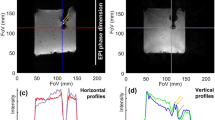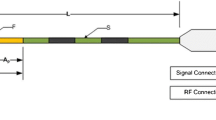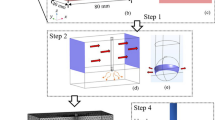Abstract
Background
Magnetic navigation system (MNS) ablation was suspected to be less effective and unstable in highly mobile cardiac regions compared to radiofrequency (RF) ablations with manual control (MC). The aim of the study was to compare the (1) lesion size and (2) stability of MNS versus MC during irrigated RF ablation with and without simulated mechanical heart wall motion.
Methods
In a previously validated myocardial phantom, the performance of Navistar RMT Thermocool catheter (Biosense Webster, CA, USA) guided with MNS was compared to manually controlled Navistar irrigated Thermocool catheter (Biosense Webster, CA, USA). The lesion dimensions were compared with the catheter in inferior and superior orientation, with and without 6-mm simulated wall motion. All ablations were performed with 40 W power and 30 ml/ min irrigation for 60 s.
Results
A total of 60 ablations were performed. The mean lesion volumes with MNS and MC were 57.5 ± 7.1 and 58.1 ± 7.1 mm3, respectively, in the inferior catheter orientation (n = 23, p = 0.6), 62.8 ± 9.9 and 64.6 ± 7.6 mm3, respectively, in the superior catheter orientation (n = 16, p = 0.9). With 6-mm simulated wall motion, the mean lesion volumes with MNS and MC were 60.2 ± 2.7 and 42.8 ± 8.4 mm3, respectively, in the inferior catheter orientation (n = 11, p = <0.01*), 74.1 ± 5.8 and 54.2 ± 3.7 mm3, respectively, in the superior catheter orientation (n = 10, p = <0.01*). During 6-mm simulated wall motion, the MC catheter and MNS catheter moved 5.2 ± 0.1 and 0 mm, respectively, in inferior orientation and 5.5 ± 0.1 and 0 mm, respectively, in the superior orientation on the ablation surface.
Conclusions
The lesion dimensions were larger with MNS compared to MC in the presence of simulated wall motion, consistent with greater catheter stability. However, similar lesion dimensions were observed in the stationary model.







Similar content being viewed by others
Abbreviations
- MNS:
-
Magnetic navigation system
- MC:
-
Manual control
References
Davis, D. R., Tang, A. S. L., Gollob, M. H., Lemery, R., Green, M. S., & Birnie, D. H. (2008). Remote magnetic navigation-assisted catheter ablation enhances catheter stability and ablation success with lower catheter temperatures. Pacing & Clinical Electrophysiology, 31(7), 893–898.
Bradfield, J., Tung, R., Mandapati, R., Boyle, N. G., & Shivkumar, K. (2012). Catheter ablation utilizing remote magnetic navigation: a review of applications and outcomes. Pacing and Clinical Electrophysiology, 35(8), 1021–1034.
Bauernfeind, T., Akca, F., Schwagten, B., de Groot, N., Van Belle, Y., Valk, S., et al. (2011). The magnetic navigation system allows safety and high efficacy for ablation of arrhythmias. Europace, 13(7), 1015–1021.
Proietti, R., Pecoraro, V., Di Biase, L., Natale, A., Santangeli, P., Viecca, M., et al. (2013). Remote magnetic with open-irrigated catheter vs. manual navigation for ablation of atrial fibrillation: a systematic review and meta-analysis. Europace, 15(9), 1241–1248.
Shurrab, M., Danon, A., Lashevsky, I., Kiss, A., Newman, D., Szili-Torok, T., et al. (2013). Robotically assisted ablation of atrial fibrillation: a systematic review and meta-analysis. International Journal of Cardiology, 169(3), 157–165.
Chun, K. R. J., Wissner, E., Koektuerk, B., Konstantinidou, M., Schmidt, B., Zerm, T., et al. (2010). Remote-controlled magnetic pulmonary vein isolation using a new irrigated-tip catheter in patients with atrial fibrillation. Circulation Arrhythmia & Electrophysiology, 3(5), 458–464.
Schmidt, B., Chun, K. R. J., Tilz, R. R., Koektuerk, B., Ouyang, F., & Kuck, K. H. (2008). Remote navigation systems in electrophysiology. Europace, 10(3), 57–61.
Latcu, D. G., Ricard, P., Zarqane, N., Yaici, K., Rinaldi, J. P., Maluski, A., et al. (2009). Robotic magnetic navigation for ablation of human arrhythmias: initial experience. Archives of Cardiovascular Diseases, 102(5), 419–425.
Miyazaki, S., Shah, A. J., Xhaët, O., Derval, N., Matsuo, S., Wright, M., et al. (2010). Remote magnetic navigation with irrigated tip catheter for ablation of paroxysmal atrial fibrillation. Circulation. Arrhythmia and Electrophysiology, 3(6), 585–589.
Arya, A., Zaker-Shahrak, R., Sommer, P., Bollmann, A., Wetzel, U., Gaspar, T., et al. (2011). Catheter ablation of atrial fibrillation using remote magnetic catheter navigation: a case–control study. Europace, 13(1), 45–50.
Schwagten, B., Szili-Torok, T., Rivero-Ayerza, M., Jessurun, E., Valk, S., & Jordaens, L. (2009). Usefulness of remote magnetic navigation for ablation of ventricular arrhythmias originating from outflow regions. Netherlands Heart Journal, 17(6), 245–249.
Kalman, J. M., Fitzpatrick, A. P., Olgin, J. E., Chin, M. C., Lee, R. J., Scheinman, M. M., et al. (1997). Biophysical characteristics of radiofrequency lesion formation in vivo: dynamics of catheter tip–tissue contact evaluated by intracardiac echocardiography. American heart journal, 133(1), 8–18.
Chik, W. W. B., Barry, M. A., Thavapalachandran, S., Midekin, C., Pouliopoulos, J. I. M., Lim, T. W., et al. (2013). High spatial resolution thermal mapping of radiofrequency ablation lesions using a novel thermochromic liquid crystal myocardial phantom. Journal of Cardiovascular Electrophysiology, 24(11), 1278–1286.
Shah, D. C., Lambert, H., Nakagawa, H., Langenkamp, A., Aeby, N., & Leo, G. (2010). Area under the real-time contact force curve (force–time integral) predicts radiofrequency lesion size in an in vitro contractile model. Journal of Cardiovascular Electrophysiology, 21(9), 1038–1043.
Faddis, M. N., Chen, J., Osborn, J., Talcott, M., Cain, M. E., & Lindsay, B. D. (2003). Magnetic guidance system for cardiac electrophysiologya prospective trial of safety and efficacy in humans. Journal of the American College of Cardiology, 42(11), 1952–1958.
Reddy, V. Y., Shah, D., Kautzner, J., Schmidt, B., Saoudi, N., Herrera, C., et al. (2012). The relationship between contact force and clinical outcome during radiofrequency catheter ablation of atrial fibrillation in the TOCCATA study. Heart rhythm, 9(11), 1789–1795.
Faddis, M. N., Blume, W., Finney, J., Hall, A., Rauch, J., Sell, J., et al. (2002). Novel, magnetically guided catheter for endocardial mapping and radiofrequency catheter ablation. Circulation, 106(23), 2980–2985.
Thornton, A., De Castro, C. B., Van Deel, E., Van Beusekom, H., & Jordaens, L. (2010). An in vivo comparison of radiofrequency cardiac lesions formed by standard and magnetically steered 4 mm tip catheters. Netherlands Heart Journal, 18(2), 66–71.
Gallagher, N., Fear, E. C., Byrd, I. A., & Vigmond, E. J. (2013). Contact geometry affects lesion formation in radio-frequency cardiac catheter ablation. PloS One, 8(9), e73242.
Lüthje, L., Vollmann, D., Seegers, J., Dorenkamp, M., Sohns, C., Hasenfuss, G., et al. (2011). Remote magnetic versus manual catheter navigation for circumferential pulmonary vein ablation in patients with atrial fibrillation. Clinical Research in Cardiology, 100(11), 1003–1011.
Acknowledgments
This study was funded by the Westmead hospital research fund. We thank the staff of the cardiology department.
Conflicts of interest
None of the authors had any conflict of interests.
Author information
Authors and Affiliations
Corresponding author
Additional information
Tony Barry was the co-first author.
Electronic supplementary material
Below is the link to the electronic supplementary material.
(MP4 9984 kb).
(MP4 22677 kb).
(MP4 25800 kb).
(MP4 28206 kb).
Rights and permissions
About this article
Cite this article
Bhaskaran, A., Barry, M.A.(., I. Al Raisi, S. et al. Magnetic guidance versus manual control: comparison of radiofrequency lesion dimensions and evaluation of the effect of heart wall motion in a myocardial phantom. J Interv Card Electrophysiol 44, 1–8 (2015). https://doi.org/10.1007/s10840-015-0023-3
Received:
Accepted:
Published:
Issue Date:
DOI: https://doi.org/10.1007/s10840-015-0023-3




